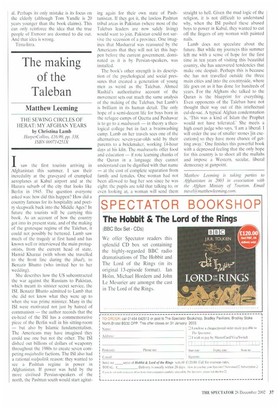God's own country
Sophia Watson
REFLECTIONS: LIFE PORTRAITS OF EXMOOR text by Birdie Johnson, photographs by Mark J. Rattenbury Dulverton and District Chic Society, £14.95, pp. 168, ISBN 0954335600; further details are available on the archive website, www.somersergov.uklarchiveslexmoor This is a puzzlingly titled book. Are we being encouraged to look on the contents as mirrored reflections of a way of life, or reflections on the death of the old Exmoor?
Perhaps we, like the Lady of Shalott, are supposed to be glimpsing shadows of the world in the pages of the book, or perhaps we are meant to be pensive about it all. In any event, while many distinguished men and women are featured, there is, alas, no sign of Sir Lancelot tirra-lirra-ing his way across Exmoor.
The book is made up of portraits of those people who have spent a lifetime on Exmoor, God's own country. The word 'community' is of course as ghastly as 'lifestyle', but it is a community that the book celebrates. These people's pride in the place where they live and work, their joy at their luck in having found themselves in this fair country, shines out of every page.
Through the faces we see, and the brief text which accompanies each, a picture is built up of a breed which might have endured privations in childhood, worked hard through wind and rain and fog through adulthood, but which loves its heritage. And nowhere is there a trace of selfpity, resentment or whining. The strongest impression left by the end of the book is of a determination to hold on to the old ways.
We meet Cyril Wyburn (b. 1911) who had to be married at 9.30 in the morning so that the vicar could go hunting afterwards; Alvina Irwin, a farmer's daughter who 'always liked a little nail varnish' (bravely un-Exmoor of her); Ada Tucker who rode over the moor to a dance carrying her dress over the pommel of her saddle. We meet a vegetarian violin-maker (actually born in Hampshire) and an 80-year-old woman who ate a pound of meat a day all her life to keep out the Exmoor cold as she followed the hunt.
We meet members of families who have been on Exmoor for generations. from Lorna Doone's Jan Ridd (a real Exmoor family) to the Luttrells who have been at Dunster since the 14th century. We meet women who never married and, now in their eighties, farm their fathers' land.
Exmoor's inhabitants are as varied as anywhere else. As well as farmers there are teachers, landed gentry, bingo-machine makers. The magnificent Dr Hardman, who never held a surgery but visited all his patients at home (often pausing to chop logs for them), is here, as is the dashing champion of the Devon and Somerset Staghounds, Tom Yandle.
Alongside the stories of the individuals we learn the stories of the place. Many witnesses refer to the great Lynmouth flood of 1952. Others remember the great freeze of 1947 when rabbits walked up snowdrifts and froze to death in treetops and ponies were found dead, nose to tail under the hedges. They had been frozen into solid blocks (an idea for Damien Hirst to consider perhaps — he is a new and faintly astonishing light on the Exmoor scene).
All in all, this is a charming book which will delight all those interested in not only Exmoor itself, but rural England in gener al. Perhaps its only mistake is its focus on the elderly (although Tom Yandle is 20 years younger than the book claims). This can only reinforce the idea that the true people of Exmoor are doomed to die out. And that idea is wrong.
Tirra-lirra.



























































 Previous page
Previous page